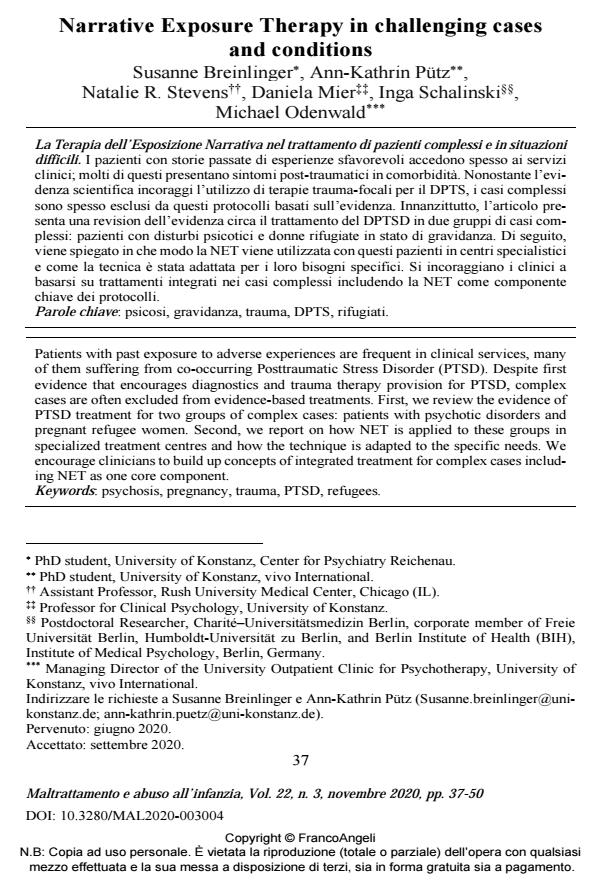Narrative Exposure Therapy in challenging and conditions
Titolo Rivista MALTRATTAMENTO E ABUSO ALL’INFANZIA
Autori/Curatori Susanne Breinlinger, Ann-Kathrin Pütz, Natalie R. Stevens, Daniela Mier, Inga Schalinski, Michael Odenwald
Anno di pubblicazione 2021 Fascicolo 2020/3
Lingua Inglese Numero pagine 14 P. 37-50 Dimensione file 209 KB
DOI 10.3280/MAL2020-003004
Il DOI è il codice a barre della proprietà intellettuale: per saperne di più
clicca qui
Qui sotto puoi vedere in anteprima la prima pagina di questo articolo.
Se questo articolo ti interessa, lo puoi acquistare (e scaricare in formato pdf) seguendo le facili indicazioni per acquistare il download credit. Acquista Download Credits per scaricare questo Articolo in formato PDF

FrancoAngeli è membro della Publishers International Linking Association, Inc (PILA)associazione indipendente e non profit per facilitare (attraverso i servizi tecnologici implementati da CrossRef.org) l’accesso degli studiosi ai contenuti digitali nelle pubblicazioni professionali e scientifiche
Patients with past exposure to adverse experiences are frequent in clinical services, many of them suffering from co-occurring Posttraumatic Stress Disorder (PTSD). Despite first evi-dence that encourages diagnostics and trauma therapy provision for PTSD, complex cases are often excluded from evidence-based treatments. First, we review the evidence of PTSD treatment for two groups of complex cases: patients with psychotic disorders and pregnant refugee women. Second, we report on how NET is applied to these groups in specialized treatment centres and how the technique is adapted to the specific needs. We encourage cli-nicians to build up concepts of integrated treatment for complex cases including NET as one core component.
I pazienti con storie passate di esperienze sfavorevoli accedono spesso ai servizi clinici; molti di questi presentano sintomi post-traumatici in comorbidità. Nonostante l’evidenza scientifica incoraggi l’utilizzo di terapie trauma-focali per il DPTS, i casi complessi sono spesso esclusi da questi protocolli basati sull’evidenza. Innanzittutto, l’articolo presenta una revision dell’evidenza circa il trattamento del DPTSD in due gruppi di casi complessi: pazienti con disturbi psicotici e donne rifugiate in stato di gravidanza. Di seguito, viene spiegato in che modo la NET viene utilizzata con questi pazienti in centri specialistici e come la tecnica è stata adattata per i loro bisogni specifici. Si incoraggiano i clinici a basarsi su trattamenti integrati nei casi complessi includendo la NET come componente chiave dei protocolli.
Parole chiave:Psicosi, gravidanza, trauma, DPTS, rifugiati.
- Os impactos da violência sobre a saúde mental global: contribuições da Terapia de Exposição Narrativa em diferentes sistemas de saúde Fernanda Serpeloni, Anke Köbach, Amani Chibashimba, Anselm Crombach, Itsuko Domen, Iván Arango, Joviana Quintes Avanci, Katy Robjant, Liliana Abreu, Maggie Schauer, Nathalie Görtz, Susanne Axelsson, Vanessa Nolasco Ferreira, Simone Gonçalves de Assis, in Cadernos de Saúde Pública e00199124/2025
DOI: 10.1590/0102-311xpt199124 - Addressing the burden of violence on global mental health: contributions of Narrative Exposure Therapy across different health systems Fernanda Serpeloni, Anke Köbach, Amani Chibashimba, Anselm Crombach, Itsuko Domen, Iván Arango, Joviana Quintes Avanci, Katy Robjant, Liliana Abreu, Maggie Schauer, Nathalie Görtz, Susanne Axelsson, Vanessa Nolasco Ferreira, Simone Gonçalves de Assis, in Cadernos de Saúde Pública e00199124/2025
DOI: 10.1590/0102-311xen199124 - Cumulative trauma predicts hair cortisol concentrations and symptoms of depression and anxiety in pregnant women—an investigation of community samples from Greece, Spain and Perú Johanna Dobernecker, Andria Spyridou, Thomas Elbert, Maggie Schauer, Susan Garthus-Niegel, Martina Ruf-Leuschner, Inga Schalinski, in Scientific Reports 1434/2023
DOI: 10.1038/s41598-023-28151-9 - Two people making sense of a story: narrative exposure therapy as a trauma intervention in early intervention in psychosis Rachel Sparrow, Miriam Fornells-Ambrojo, in European Journal of Psychotraumatology 2355829/2024
DOI: 10.1080/20008066.2024.2355829
Susanne Breinlinger, Ann-Kathrin Pütz, Natalie R. Stevens, Daniela Mier, Inga Schalinski, Michael Odenwald, Narrative Exposure Therapy in challenging and conditions in "MALTRATTAMENTO E ABUSO ALL’INFANZIA" 3/2020, pp 37-50, DOI: 10.3280/MAL2020-003004